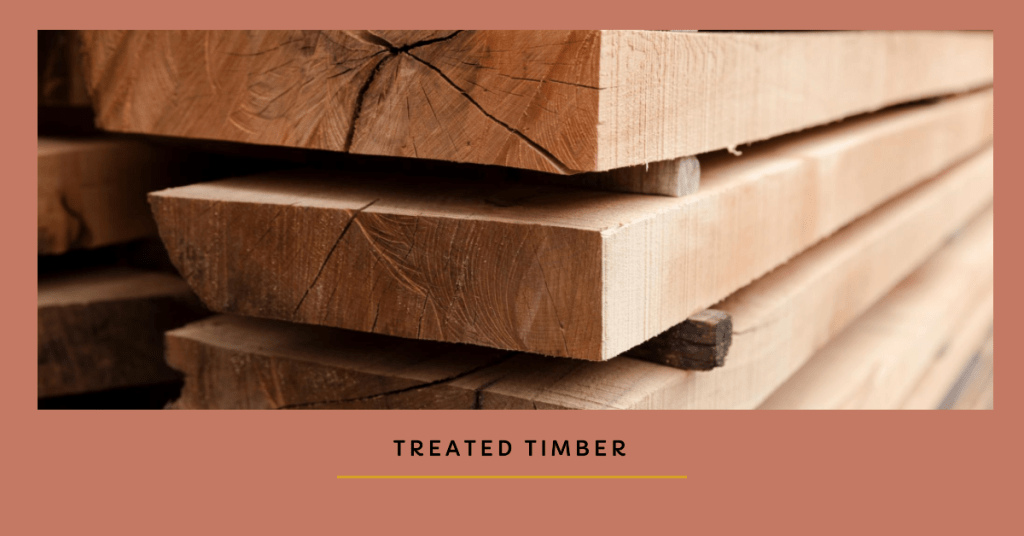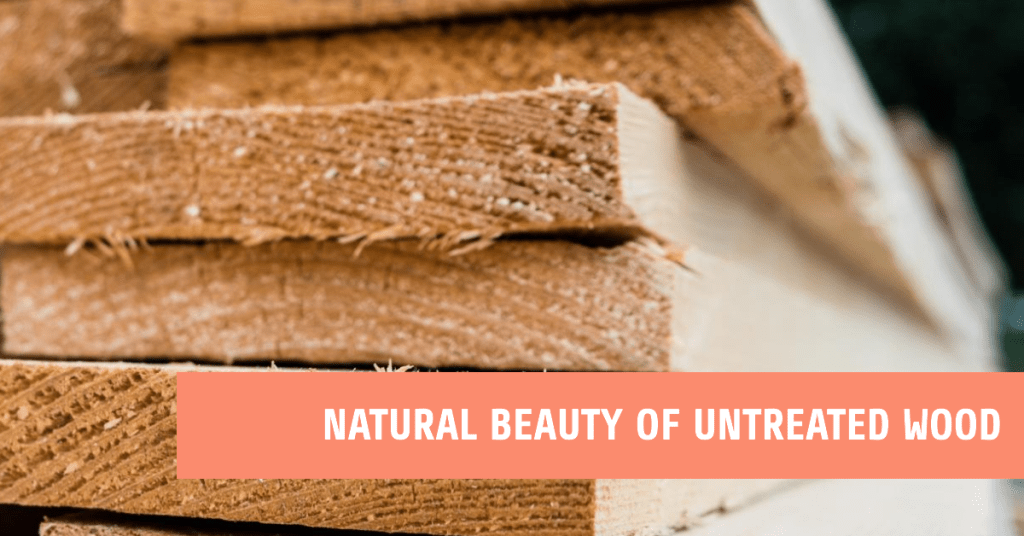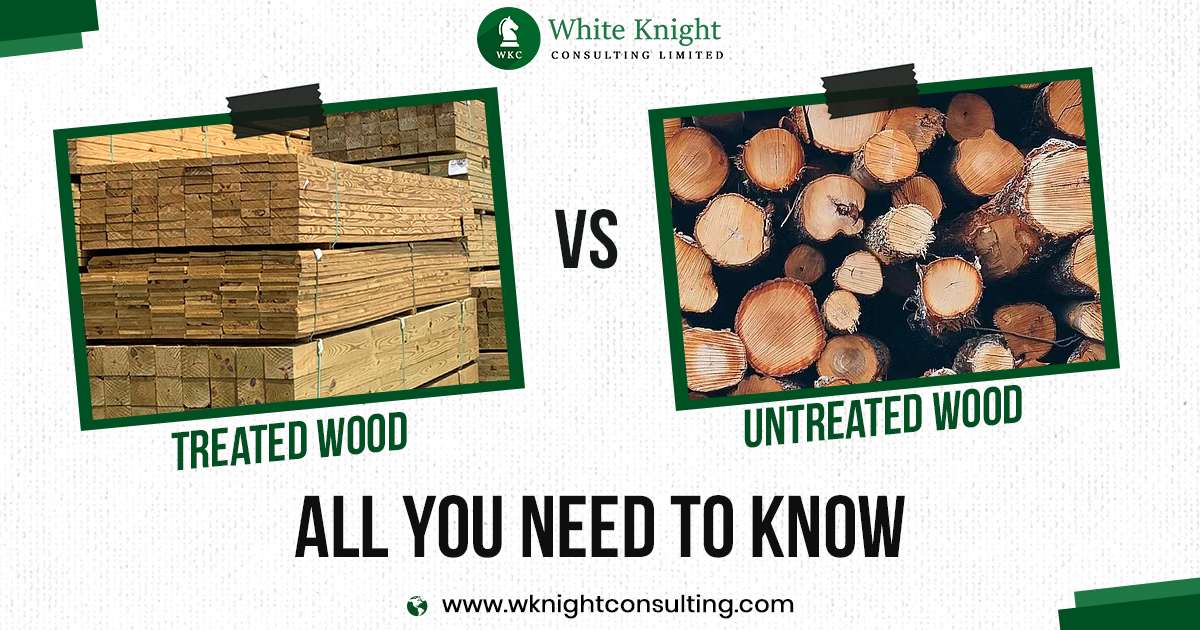Wood is one of the most popular construction materials used both for interior and outdoor projects. Timber is usually available in two forms – treated and untreated timber. Choosing between treated vs untreated wood can be crucial for the success of your woodworking project.
While treated timber has been processed to enhance its properties and features, including durability, the untreated timber is solid wood in its natural state. In this article, we talk about the benefits and features of treated and untreated timber to help you choose the right one for your project.
What is Treated Wood?

Treated wood or timber is achieved by pressure-treating natural wood. The process involves treating the wood with chemicals under specific pressure and temperature conditions to enhance its durability in terms of resistance to rot, decay, insects, etc. The wood is placed in a pressure chamber and treated with preservatives, using pressure treatment, to enhance its strength and durability from the inside.
Pressure-Treated lumber is of the best quality, highly durable and very resistant to decay and insect attacks, which makes it a perfect choice for a range of applications, including outdoor woodworking projects such as boatbuilding, outdoor furniture, decking, cladding, etc.
The most popular chemicals used in the wood treatment process include chromated copper arsenate (CCA), ACQ, and copper azole (CA). These wood-treating chemicals are tested to be safe for humans and the environment.
Advantages of Treated Lumber
There are many reasons why woodworkers choose treated timber over untreated wood. Here are some:
- Enhanced Durability: As mentioned before, treated timber is very durable. The chemicals used in the treatment process helps enhance the strength and durability of the wood to protect it from rot, decay, and insect damage, as well as extend its lifespan. Pressure-treated wood can witness high amounts of load and survive in extreme weathering conditions.
- Water Resistance: One of the reasons to treat wood is to make it resistant to moisture to avoid fungal decay problems. Treated lumber has outstanding moisture resistance. Due to the presence of preservatives, the wood doesn’t absorb moisture easily, which helps reduce the risk of warping, splitting, and shrinking due to water contact.
- Protection from Insects: Treated lumber is immune to a variety of insects, especially insects that can eat up or damage wood. These include termites, carpenter ants and other wood-boring insects. Thanks to wood treatment, it becomes resistant to insect infestations. This protection can be crucial in places with high termite activity.
- Extended Lifespan: Pressure-treated wood has enhanced durability and is resistant to decay, which can help increase your furniture’s lifespan by many years. It will also help you save money over time, as less maintenance is needed over time.
What to Consider When Buying Treated Wood?
If you are considering buying or using treated timber, here are a few things to consider:
- Chemical Exposure: One of the first things to consider when choosing treated lumber is the likely exposure to chemicals during the treatment process. While application to preservatives within allowed limits is considered safe for most applications, it is recommended to take precautions when handling and cutting treated timber. For example, woodworkers must wear gloves and a mask to avoid any health impact.
- Environmental Impact: The use of chemical preservatives for wood treatment might also have an impact on the environment. For example, preservatives containing copper or similar elements can eventually get into the soil or water, making them unsafe for use. To avoid such issues, it is essential to make sure that your timber has been treated by following proper environmental guidelines. Avoid using treated wood in sensitive places like vegetable gardens or water bodies.
Understanding the Untreated Lumber

Untreated lumber is wood in its natural state, i.e. solid wood that hasn’t been given any chemical treatment. Untreated timber is naturally the safest kind of timber and is typically favoured for indoor applications such as furniture and cabinetry. However, untreated lumber is susceptible to mold growth, which can compromise its structural integrity and pose health risks. It may not be the best kind of wood in terms of strength and durability.
Advantages of Untreated Timber
- Aesthetic Appeal: Untreated wood maintains its natural beauty, as the wood grain and textures have not been altered by preservatives. This makes it an ideal choice for projects where the attractiveness of the wood is a priority. Examples include furniture, crafting, decorative items, etc.
- Versatility: Untreated timber provides great variety in terms of natural wood appearance, customization and finishing options. Wood that has not been chemically treated can be seamlessly stained, painted, or varnished to achieve the desired look.
- Environmentally friendly: Untreated wood is one of the most eco-friendly materials for construction. As mentioned before, chemicals present in treated lumber may be harmful to the environment and people. This is not a problem with natural, untreated lumber.
- Perfect for Indoor Applications: Untreated timber is the best fit for indoor projects due to the fact that it is more aesthetically appealing and less durable than treated timber. It can be used for a range of interior applications such as interior trim, cabinetry, flooring, and shelving.
Comparing Treated and Untreated Lumber
Treated Vs Untreated Wood: Appearance
Upon treatment, wood might react with chemicals which can cause changes in its appearance, including fading or darkening of colour, altering of natural wood grain or pattern, etc. Also, it can make the wood difficult to identify.
Untreated lumber gives a more natural and organic appeal as the wood retains its original appearance. It is also easier to work with and can be seamlessly customized to achieve the desired finish.
Treated Vs Untreated Wood: Basic Properties
Treated wood is processed lumber that is created by chemically treating natural wood to enhance its properties and durability. The result is a more durable wood with resistant to decay, insects, and water. Another reason why wood treatment is done is to enhance the lifespan of the wood. While natural lumber will last about a few years, treatment can expand its life by a few more years. Treated wood is suitable for both indoor and outdoor applications.
Untreated wood is natural lumber without any treatment or chemical processing. This is the purest form of timber that retains its natural colour and appearance and can be moderately o very durable depending on the species. Untreated wood is considered more prone to rot and insect attack than treated wood and may not be suitable for outdoor projects.
Treated Vs Untreated Wood: Strength & Durability
One of the primary reasons for wood treatment is to enhance the product’s durability and protect it from external factors including weather and insects. Wood is prone to external elements such as moisture that can cause it to decay and insects that can damage it over time. The chemical treatment process makes the wood stronger from the inside, thereby preventing the growth of fungi and decay, and providing protection from insects, including termites.
Treated wood is also more immune to moisture, as it doesn’t absorb moisture very quickly and is, therefore, suitable for ground contact or high-humidity places. This type of wood can easily withstand exposure to severe outdoor conditions, including harsh weather and helps ensure a longer lifespan compared to untreated wood.
On the other hand, untreated wood may not be as strong or durable as treated wood. It lacks qualities like higher durability. It is more prone to moisture, decay, rot, and insect attack, especially when used in outdoor projects. Untreated wood which is not naturally durable is not suitable for outdoor use. It will start decaying when in contact with water for a long time. It is important to understand the different types of lumber available, including treated and untreated, to make informed decisions for your projects.
Untreated wood, however, is favoured for its natural appearance, versatility, and environment-friendliness. It is also generally safer to work with than treated wood.
Treated Vs Untreated Wood: Applications & Uses
Because treated wood is more durable, it is mainly used in outdoor projects. Some common uses of treated timber include building decks, fences, outdoor furniture, flooring, pergolas, cladding and other structures intended to be used outside.
Treated wood is also considered suitable for landscaping projects. Because of its water-resistant nature, this wood is a good choice for boatbuilding and other marine applications.
When using treated timber, one must always follow safety guidelines and wear gloves and masks.
Untreated wood is generally easier to work with. They are easy to finish and paint and can be used in a variety of projects, mostly indoors because of their limited durability. Common uses of untreated wood include interior furniture construction, cabinetry, interior trim, and flooring.
There are also available many untreated or solid timber species that are naturally very strong and durable and have good resistance to water and insects.
Treated Vs Untreated Wood: Environmental Impact
We have already talked about the possible environmental impact of treated wood. The use of chemicals in the wood treatment process can be harmful to the environment, including the earth and water bodies if treated wood is in direct contact. Chemicals will eventually start affecting the environment near them, which is why necessary precautions must be taken when using treated wood.
Untreated lumber is mostly safe for the environment, given that it is produced and sourced sustainably. Wood is a naturally compostable and recyclable material and doesn’t harm the environment, water or the earth even when decomposing.
Where to Buy the Best Quality Treated or Untreated Timber Online?
When choosing between treated and untreated timber, one must consider various factors, such as the treatment type and level, project cost, environmental impact, and personal preferences. Treated lumber is more durable and resistant to moisture and insect. It can enhance the wood’s life.
Untreated lumber, on the other hand, is a more natural and organic product, which offers variety and is friendly to the environment.
Visit White Knight Consulting LTD to learn more about treated and untreated wood and buy your favourite timber at wholesale prices with doorstep delivery all over the world. Contact us to send your enquiries.
